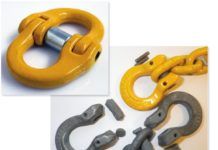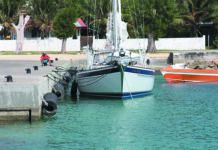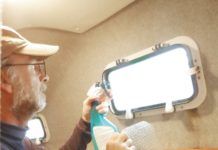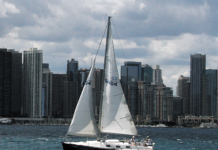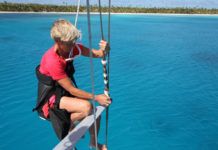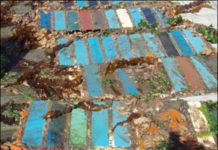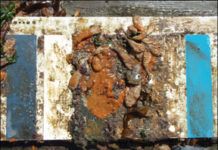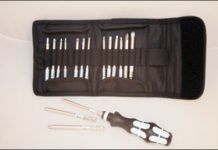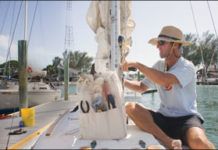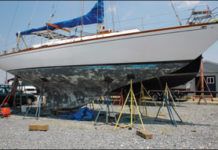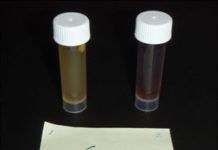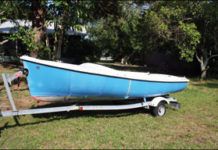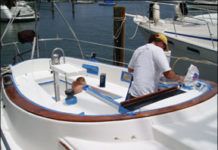Last Call for Top-Rated Bottom Paints After Two Years
Our two-year test wraps up with 20 top-rated paints. Unlike the last two-year results when hard paints dominated, the group is split with 10 self-polishing or ablative paints and 10 hard paints. Our Recommended, Best Choice, and Budget Buy picks also are divided pretty evenly. In past rating cycles for this panel set (October 2007 and March 2008), Interlux Micron 66 and Sea Hawk Biocop TF were named top picks. These two still lead the pack at the two-year mark. Both are expensive, with Micron 66 costing $220 per gallon and Biocop TF ringing in at $228 per gallon. They also both use zinc pyrithione as an anti-slime agent. Our top bright-color paint after two years in the water is Blue Water Kolor-another expensive paint, priced at $170 per gallon. The top-performing two-year paint suitable for race boats is Interluxs VC Offshore. Pettit Trinidad SR, well polished, would also be a good choice for racing.
Bottom Paint Test Report: Panels Rated at the One- and Two-year Marks
Looking for the best marine antifoulant to keep your hull clean? Check out Practical Sailors semi-annual bottom paint test report, which offers performance ratings on nearly 80 marine antifouling paints. Multiple sets of submerged fiberglass test panels-two in the Florida Keys and two in Long Island Sound-were pulled and examined for their resistance to hard growth and soft growth. Detailed charts show the results of the one-year and two-year tests for ablative paints, hard paints, and specialty paints (white paints, eco-friendly paints, bright paints, water-based paints, and racing boat paints). After the ratings were logged, testers retired the two-year panels to make room for the 2008 bottom paints. This lineup-72 paints in all-includes several low-copper paints and no-copper paints, which are becoming increasingly popular as sailors look for viable alternatives to metal-based paints. Paint manufacturers and distributors participating in the test include Blue Water Marine Paint; Donovan Marine; Epaint Co.; Flexdel Aquagard; Interlux Yacht Finishes; Kop-Coat; Pettit; New Nautical Coatings; Seahawk Paints; West Marine; and Boaters World (Seabowld). Among the top-rated paints are Interlux Micron 66, Interlux Super Ablative, Pettit Ultima SR, Pettit Trinidad SR, Pettit Unepoxy Plus, Pettit Vivid, and Sea Hawk Biocop TF.
Wera: Stainfree with Stainless
According to German toolmaker Wera Tools, much of the corrosion we find in the cross-hairs of our Phillips-head and other stainless-steel fasteners is a result of cross-contamination during the tightening process when traditional, carbon-steel tools are used to secure the fastener. Small bits of the carbon steel are embedded in the fastener, and the particles form galvanic cells that quickly corrode or leave a pit. Solution? Stainless steel tools-the logic being that using stainless on stainless, there will not be any contact corrosion, and therefore no rust.
Diddy Bagg is More Than a Tool Bag
Practical Sailor testers are constantly schlepping tools between the Practical Sailor workshop, our own garages, and—of course—our boats. So we’re always on the lookout for a toolbag that makes said schlepping a little easier. Enter the Original Nantucket Diddy Bag, which we came across at a recent boat show. It is the first tool bag we’ve seen that is reversible and convertible. Designed by a Nantucket carpenter, the bag’s well-thought-out design is practical and versatile. With 36 various-sized pockets (including a hidden one in the bottom), the bag makes tools easy to find and keep organized—no more digging to the depths of a cluttered tool bag.
Mailport: 10/08
Your recent assessment of the locator service SPOT (Practical Sailor September 2008) was spot on. We recently took it along on a Pacific Coast, offshore delivery of a 50-foot sailboat. We hit bad weather and had several mechanical failures. Our families ashore were able to follow our progress on the SPOT website throughout our trip. The problem came when a panicked crew, unknown to me, hit the "911" button. I was able to cancel the 911 call a few hours later. Our families were simply alerted that we had a serious problem but did not know anything more for a couple days. The SPOT command central repeatedly called my cell phone, which was with me, 250 miles offshore and obviously out of range. They claimed they could not determine our position despite several days of track records.
SteriPEN Portable UV Water Purifier
Cruising sailors who venture to the fringes of civilization, or to attractive but perhaps unsanitary foreign ports, or even to unfamiliar marinas, often have reason to view the sources of their drinking water as dodgy. Unless theyre willing to carry bottled water or have a watermaker on board, they catch as catch can, and sometimes what they catch isn't any fun. Boiling water and adding chlorine or purification tablets is a standard way of dealing with potential drinking water problems, but sailors may also want to consider a simple, relatively inexpensive gadget that trail-hikers, mountaineers, and other land-oriented adventurers have known about for the past few years. The SteriPEN, one of Readers Digests 2007 "25 Products That Will Change Your Life" and Wireds "25 Gotta Have Gadgets of 2008," kills water-borne viruses, protozoa, and bacteria with ultraviolet light, wrecking their DNA.
Practical Sailor Searches for The Best Gelcoat Restorer
Acrylic fiberglass coatings are a practical alternative to use on your sailboat’s gel coat when waxes and polishes won’t revive that gelcoat shine. Practical Sailor tested seven new acrylic hull restorers designed to get rid of oxidation: Higley Fiberglass Restorer, Klasse High-Gloss Sealant Glaze, NewGlass2 (NuGlass2), Poli Glow, Star brite Glass Cote, Vertglas, and Presto gelcoat rejuvenator. The top performers were easy to apply and left the old, porous hull with a mirror-like shine.
All Plywood Not Created Equal
I was wondering if you folks have ever evaluated the various kinds of plywood for use in marine environments. Needing to replace a bulkhead, I went plywood shopping with a friend. Its his belief that theres little difference between regular plywood and marine plywood, other than the price. He says its all the same glue, and that different glue wouldnt matter because wood is wood and it all delaminates the same when exposed to water. What are your thoughts?
Painting Your Own Deck
My wife and I have owned our boat since 1985. We now keep it in the British Virgin Islands, where the Caribbean sun is tough on finished wood and fiberglass. The reason I am writing you is to get your true feeling about novices handpainting our decks. We want to keep the nonskid and the white border design we currently have. The decks were Awlgripped by the factory in 1992, but this has turned chalky and shows tremendous wear. Is it feasible to try such a project? Or should I just pony up the money to have it done? We have time and plenty of elbow grease and a willingness to try.
Topside Paint Test Kicks Off with a Look at Application and Gloss, Tips and...
Practical Sailor applied 29 topside fiberglass paints from nine manufacturers to fiberglass panels and rated them on handling, coverage, and gloss. Paints will be evaluated for long-term durability and gloss retention over time. Seven of the paints are alkyd enamels; 12 are one-part urethanes; and eight are two-part linear polyurethanes. Two paints were classified as "other." Paints tested included alkyd enamels from Kirby, Sherwin-Williams, and Pettit Z-Spar; one-part urethanes from Epifanes, Insignia, Interlux, Pettit, and West Marine; and two-part polyurethanes from Epifanes, Awlgrip, Fabula, Insignia, Interlux, and Sherwin-Williams. Two Crab Coat paints from CrystaLac also were tested. Looking for tips on painting topsides yourself? PS also takes a look at the tips, tools, and techniques of do-it-yourself topside painting.











